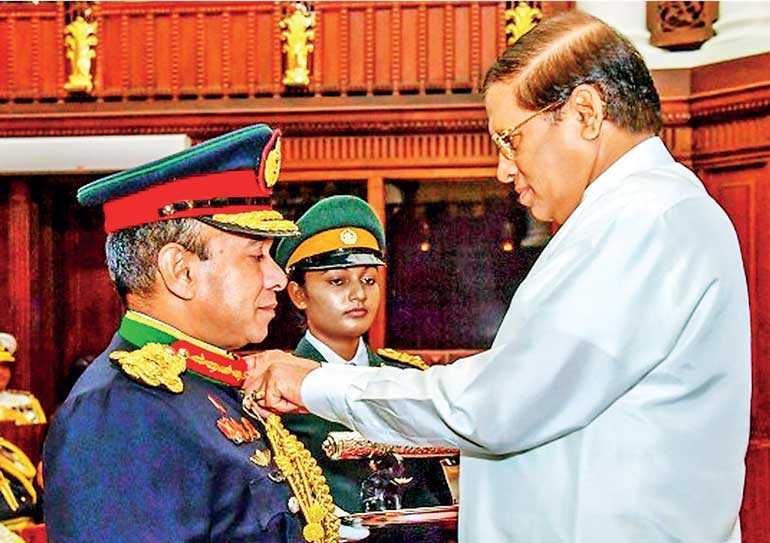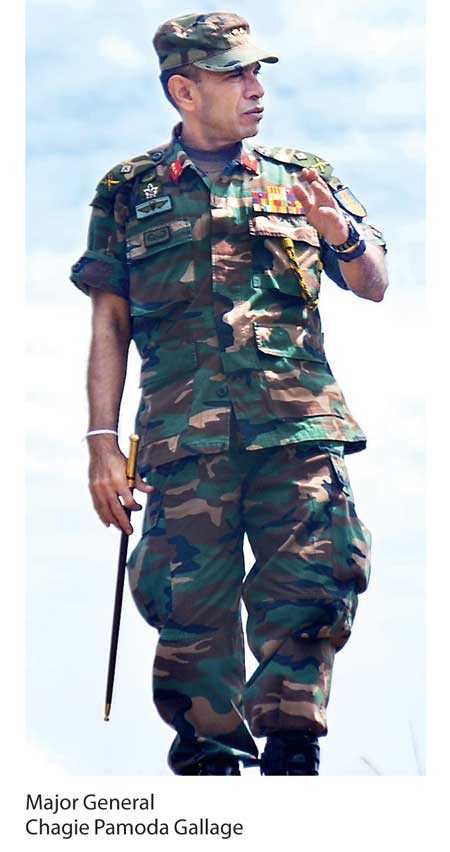Sunday Dec 15, 2024
Sunday Dec 15, 2024
Friday, 7 September 2018 00:00 - - {{hitsCtrl.values.hits}}

 By Maj. Gen. Nirmal Dharmaratne
By Maj. Gen. Nirmal Dharmaratne
Major General Chagie Pamoda Gallage, WWV RWP RSP VSV USP USAWC, a true patriot, a soldier to the inner bone, an inspiring military leader and a gentleman to the fingertips, hung up his uniform on 31 August, after 35 years of arduous service to the nation, having reached the maximum permissible age of service (55 years) in the Army.
Having known Major General Gallage, for over three decades, I trust that I can pen many distinct attributes of him with absolute authority and accuracy.
Major General Chagie Gallage, whom I will respectfully and fondly call hereinafter as ‘Chagie’, was my senior colleague in the Army, an officer of repute of the prestigious Gajaba Regiment, who always upheld customs, traditions and ethics of the organisation, left a legacy that cannot be repealed in the Sri Lanka Army and in the Gajaba Regiment.
General Gallage is no doubt a national figure. To gain such recognition he did not blow his own trumpet nor did he write an autobiography. It is the humility embedded in his persona that brought him this adulation. Although, Chagie became popularly known to the public in Sri Lanka because of the decisive role he played in the final thrust against the LTTE terrorists in 2007-2009 period, he has always been very popular among his comrades in the Army, among his batch mates, among old Anandians, among the motor racing community of Sri Lanka, among his relatives and among many of his friends.
Somewhat burly and diminutive, a keen ruggerite and a Scout at school, Chagie joined the 19th Intake of the Army as an Officer Cadet in 1984. Chagie took to the military career like a fish taking to water. I recall seeing him for the first time at the Military Academy in Diyatalawa from a batch junior to him, and essential attributes of a great military commander were evident all over in him, even at that very formative stage of his military career. Tough and robust, both mentally and physically, Chagie was so charismatic and inspiring to watch.
Chagie as a person is ever so willing to help others always. He is one in a million who never changed his qualities from his youth to date. That is to say that if you had known Chagie in 1984 when he was twenty years of age, and then even in 2018 in his mid-fifties, you would meet the same character, which is not so with many others. He was an adornment to the positions he held, and did not use the positions to adorn himself. This no-nonsense officer could also get stubborn easily and stand for what is right against all odds, which sometimes got him into troubles too.
Chagie’s contributions to the Gajaba Regiment has been outstanding. Gajaba Regiment is synonymous with Chagie Gallage. Chagie as a young subaltern, in mid-eighties, was a very skilful and tactically-sound combat fighter who operated along with his rifle-company in many areas of Jaffna peninsula. His first independent command was to guard the Nagadeepa (Nainativu) island in 1986 with his platoon. He played a key role in the Operation Vadamarachchi and Operation Clean-sweep – the two military operations led by the two great late Generals Kobbekaduwa and Wimalaratne, which were launched to rid the terrorist out of Jaffna peninsula in 1986.
I presume that Chagie’s stint at the Sri Lanka Military Academy (SLMA) as an officer instructor is one of his most memorable. Working under late Major General Gamini Gunasekera, Chagie not only excelled in training Officer Cadets, but also became one of the pioneers of organising motor racing competitions in the Army, in partnership with the ‘Sri Lanka Auto-sports Drivers Association’ (formerly SLARDAR), the flourishing sport in Sri Lanka, the journey of which began at Fox-hill, Diyatalawa. The motor racing track at Gajaba Regiment in Anuradhapura is a result of hard work of Chagie.
During most of his long and enduring military career, Chagie served either in an operational area or at a military training institute. He is one of the few officers of the Army who always commanded respect not only from his subordinates but also from his superiors and peers. Battle-hardened Chagie was the first choice of any senior military commander, to include in their team of field commanders for operations. Thus, Chagie was seen in almost all major combat operations in all fronts, in North and East, during the period from 1985 to 2009.
Some called Chagie a ‘meticulous man’ because he goes into minute details of any assignment, and that particularly is the reason for his success. Be it official or private, he was always well focused on whatever he was doing. Duty was always at his heart that he would stay the whole day in uniform doing his job exceeding expectations of his superiors. Chagie would do all the work around him disregarding whether that work is within his purview or others, and would stay back-stage without claiming credit for the achievement. By doing so, he gained a reputation among the senior officers and confidence among the juniors, which was one of the reasons for his seniors to count heavily on him, and his juniors to place faith on him.
‘Calmness in crises is a much-required quality of a good battlefield commander. Once during a very intense battle at Karadipokku in Kilinochchi, during Operation ‘Sathjaya’ in 1996, the Army suffered heavy casualties and the battle was about to be lost. It is at this crucial moment Chagie came in voluntarily without waiting for instructions from superiors, and led his elite Airmobile troops to fight gallantly and restored the situation and at the end Chagie too was wounded. While being treated at the ‘Advanced Dressing Station’ (first aid point just behind the line of fire) the LTTE fired a barrage of mortars to that location. At this moment, while other casualties were yelling in agony, and running around for cover carrying their saline bottles in hand, Chagie lit a cigarette.
During the ‘Humanitarian Military Operation’, Chagie as a Brigadier commanded the Commando Brigade, which had been grouped with some infantry battalions, with which he moved into action against LTTE in the Eastern Province in 2006. Chagie’s leadership was instrumental in liberating the Southern part of the Eastern Province that included the LTTE stronghold Thoppigala. Then Chagie switched to the Wanni theatre with the beginning of operations in the Northern front in 2007. He raised the Task Force-1 there and launched it from Mannar front, along with Commando Brigade, which was later driven by Chagie’s closest pal in the Regiment, Maj. Gen. Shavendra Silva until the completion of Eelam War, which was later upgraded as 58 Division.
Thereafter, being away from battle due to a brief illness, Chagie returned to the field in 2009 to Command the 59 Division in Mullaitivu front. On completion of the campaign, Brigadier Chagie Gallage was promoted to Major General prematurely well ahead of most of his peers, on merit. Chagie not only earned gallantry medals multiple times for his bravery in battle, but he also worked hard to get gallantry medals for his juniors too.
Chagie is extremely innovative; he could device things when the resources are scarce or unavailable. I recount how, Colonel Chagie, as the Commandant of Army Training School in Maduruoya, in 2004, was instrumental in conceptualising and forming the highly skilled ‘Special Infantry Operations Teams’ (SIOT) of the Army, together with Lt. Col. Ralph Nugera, realising a vision spelt out by then Inspector of Infantry, Major General Sarath Fonseka. It was these SIO Teams that boosted the fighting capacity of infantry and fought as vanguards of the advancing Army during the Humanitarian Military Operation.
On another occasion, during the middle of the same military campaign, Army encountered highly-fortified LTTE fortifications built on ‘Ditch cum Bund’, commonly known as ‘DCB’ (DCB is a line of bunkers coupled with about 10 foot wide water obstacle in front of them). These obstacles severely hindered the movement of the advancing Army. Chagie as the Director Training, under the direction of the Army Commander, created special teams and trained them on a special battle drill that eventually enabled troops to successfully cross these LTTE obstacles.
Any Army would pick one of its highly-professional and unswervingly loyal military officers to command its ‘Presidential Guard’ force that provides protection to the Head of State. His superiors at that time had no hesitation in recommending Chagie to that vital appointment, which he held successfully for four years from 2010.
Matured to the core, totally dedicated to excellence in all its manifold facets from command to instructional, the Army received Chagie’s services as a Tactical Level Commander and thereafter as an Operational Level Commander, proving himself a well-accomplished General officer. The Army in particular and the country in general have received tremendous service from this great legendary military leader of our time. Yet he never grumbled about what he did not get in return.
Leadership of Maj. Gen. Chagie Gallage should be researched and documented, for the benefit of budding military leaders. A good source for such a research is his close associates, both in and outside the Army, who know his inner qualities well. It is my sincere wish, as well as of many others whom I know, that the outstanding potentials of Major General Chagie Gallage (retired) may be utilised for the benefit of this country for a few more years.
(The writer was Commander of the Special Forces Brigade, 2007-2009.)